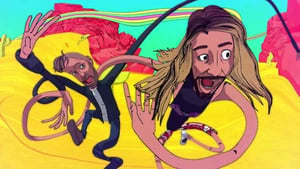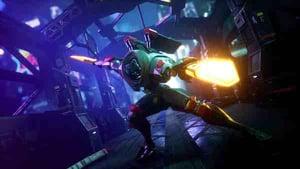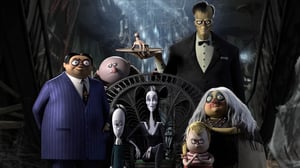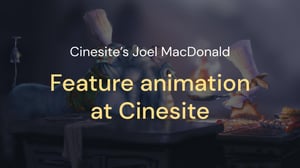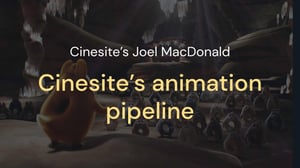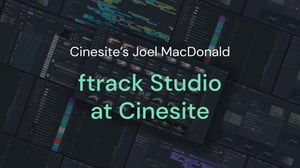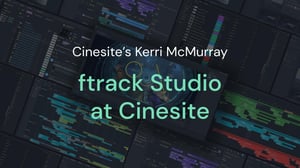
Cinesite sketches out a new future in animation with ftrack Studio
Cinesite is one of the world’s most prominent creative studios, with credits on James Bond, Harry Potter, The Witcher, and a whole lot more besides.
Over 30 years, Cinesite has created enough characters, creatures, and environments to fill a small universe. An average week could see the Cinesite team conjuring up swamp battles between demonical Kikimoras and a dark-eyed Witcher, telling the story of Natasha Romanoff in Black Widow, or launching once again into the world of James Bond for Daniel Craig’s final outing in No Time To Die. Cinesite’s work is varied and never strives for anything less than the highest possible quality.
However, Cinesite doesn’t just work in the realm of visual effects. In 2016, Cinesite announced the launch of its dedicated feature animation division at its Montreal studio followed by the opening of its Vancouver facility in 2017. Over the last five years, the Canadian studios have created two Addams Family feature animations, brought the traditional Irish Riverdance show to life in Riverdance: The Animated Adventure, collaborated on the CG short Mila with director Cinzia Angelini, commenced work on the Mel Brooks’ inspired Blazing Samurai, and so much more.

Production Manager

Producer
Company: Cinesite
Website: cinesite.com
Location: London, Montreal, Vancouver
Capacity: 1,550 artists and technicians
Although Cinesite makes it look easy, creating a new animation pipeline doesn’t just happen overnight. Cinesite’s Montreal team has spent the last five years developing, refining, and improving an animation pipeline that’s only growing more impressive. Below, we speak with Cinesite Production Managers Kerri McMurray and Producer Joel MacDonald about how Cinesite transformed its pipeline and expanded from Hollywood visual effects into the world of feature animation and how ftrack Studio has helped ease the transition to a whole new medium.
A world of animation
When Cinesite expanded from visual effects into animation, several things had to change. First, the team needed to create an even more scalable and flexible pipeline capable of managing the increased workload animation projects would bring. “The big difference between visual effects and animation is in the volume of work,” begins Joel, who has extensive experience working across both disciplines. “In feature animation, you’re dealing with 1,500 shot shows. In visual effects, such high shot counts are rare, as you’re typically one of many vendors sharing the work.”
Animated films also generally posit longer turnaround times than visual effects projects, meaning Cinesite’s animation pipeline had to marry scalability with stability. “Unlike visual effects, animation isn’t a sprint; it’s a marathon,” continues Joel. “We needed to ensure all of our visual effects tools could be used by more people, for longer.”
However, whatever Cinesite’s new pipeline introduced, it also had to remain faithful to an important studio value: innovation. Whether working on live-action or otherwise, experimentation, exploration, and the ability to develop new ideas remained critical.
“The animation industry is very competitive, so you need to keep up,” adds Joel. “We update our animation pipeline every week. Sometimes this means fixing small bugs, other times it means more significant changes, like recently switching to Gaffer as our rendering software.”
Staying in touch
Communication remains a vital component of Cinesite’s animation pipeline. Cinesite relies on ftrack Studio to keep teams connected, whatever the project they’re working on. “ftrack Studio is super important in our pipeline and workflow,” says Kerri. “We use ftrack Studio to discuss work and make sure everyone knows what they need to do, from project start to end.”
Even when a project is over, ftrack Studio plays a vital role in selecting what will run through the Cinesite pipeline next. “We regularly run retrospectives where we look back at a project and discuss what went well or what in the pipeline might need work,” explains Kerri. “We pull data from ftrack’s production tracker to make sure the hard facts match our gut feelings.
“As we always bid on projects, whether we’re producing them for ourselves or a client, analyzing this historical data is key. Looking at production data in ftrack Studio ensures our bidding is accurate and reveals areas where we must focus our innovation to increase future efficiency. For example, a few years ago, it was rare to have more than 30% of shots featuring cloth simulation—now, almost every shot has some kind of material FX. Such data is reflected in ftrack Studio; seeing it helps us prepare and evolve our pipeline tech for these trends and client expectations.”
"ftrack Studio helps us manage changes or avoid over-working a shot. We're all focused on what we need to do."
Joel MacDonald
Producer, Cinesite

Embracing Creativity
ftrack Studio also reduces what Joel calls “complexity creep”—when work on a sequence starts taking longer than expected as new feedback comes down the line. “ftrack Studio helps us manage these changes or avoid over-working a shot that’s only shown for a couple of seconds,” he says. “We’re all focused on what we need to do and how, as all necessary information is shared in ftrack Studio. The data is easily accessible to everyone who’s working on the shot.”
Such time-saving measures endow Cinesite’s team with more time to focus on creative inspiration, and the results are clear. Cinesite’s work on updating pop-culture staple The Addams Family, for example, is a testament to the team’s animation talent and what’s possible when a team has efficiency and collaboration on their side.
“One of the exciting things about animation and storytelling is that you often wield a greater creative contribution than we might have in visual effects work,” says Joel. “In animation, you’re not just working on the post end of production; you’re involved from storyboarding or even the writing stage right through to the final composite and you work with everyone, including sculptors, painters, actors, and the people writing code. Seeing it all come together across the pipeline, from an idea into this final, wonderful imagery on screen, is incredible. We’re thankful to ftrack Studio for being part of the process that helps us get there."
Try Ftrack for free
Start your free trial and see how Ftrack can connect your team and boost your animation workflow.
More customer success stories
